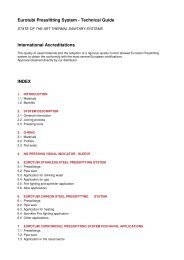Vis PDF - Damstahl
Vis PDF - Damstahl
Vis PDF - Damstahl
You also want an ePaper? Increase the reach of your titles
YUMPU automatically turns print PDFs into web optimized ePapers that Google loves.
Chapter 1: What is Stainless Steel?<br />
Stainless steel is a large group of metals with a couple of properties in common: The main element<br />
is iron (> 50 % Fe = “steel”), and apart from that the steel contains at least 10-12 % chromium (Cr).<br />
In its simplest form, no other elements are required in order to make “stainless steel”, proved by the<br />
fact that the simplest possible stainless steel (EN 1.4003) contains only 10.5 % Cr, and the rest is<br />
iron.<br />
Historically, the simple chromium alloyed steel types were invented back in 1912. In 1913, the<br />
German Krupp Company added nickel (Ni) in order to improve the mechanical properties (the birth<br />
of the austenitic stainless steel), and in 1920, the beneficial effect of adding even small amounts of<br />
molybdenum was observed. Thereby, the “acid resistant” stainless steel was invented.<br />
Apart from chromium and nickel, the steel may contain a large array of other elements, all of which<br />
affect the mechanical or chemical properties in one way or the other. The description of the effect<br />
and importance of the different elements is enclosed in Chapter 2.<br />
According to their microstructure, the stainless steel types may be classified into five main groups:<br />
Austenitic Stainless Steel<br />
Usually recognized by a high content of chromium (Cr), high nickel (Ni), low carbon (C) and frequently<br />
molybdenum (Mo, up to 6 %), the austenitic group is by far the largest and most important<br />
type of stainless steel, and both the common EN 1.4301 (18/8, AISI 304) and the acid resistant steel<br />
types (4401/04, AISI 316(L) etc.) belong to this group.<br />
Among stainless steel, the EN<br />
1.4301 and 4401 types still make<br />
out about 70 % of the world-wide<br />
market. These welded pipes are<br />
made of ”common stainless steel”,<br />
4301.<br />
Mechanically, the austenites are recognized by being non-magnetic;<br />
however, cold deformation may lead to the steel being slightly magnetic.<br />
In general, the austenitic steel types possess a long elongation<br />
(A5). This implies great ductility, and the austenites are generally soft<br />
and particularly adapted to plastic deformation such as deep drawing<br />
of kitchen sinks.<br />
Compared to the other types, the ductile austenites behave a bit like<br />
“chewing-gum”, and the excellent combination in between the mechanical<br />
ductility and the corrosion resistance has ensured that the austenites<br />
are still the most widely used group of stainless steel. Anything<br />
from door handles to king-size brewery tanks are made of austenitic<br />
stainless steel.<br />
In contrast to the ferritic, martensitic and duplex types, the austenitic<br />
steel types do not suffer from brittleness at very low temperatures,<br />
and their tendency to suffer from ”creep” at higher temperatures is lower<br />
as well. In addition, the corrosion resistance of the austenitic steel<br />
types is generally high; however, in particular the lower ones (4301<br />
and 4401 classes) are vulnerable to stress corrosion cracking (SCC, see<br />
Chapter 4). For that reason, the austenites are not always useful in<br />
warm conditions.<br />
www.damstahl.com<br />
01.2013<br />
282
















